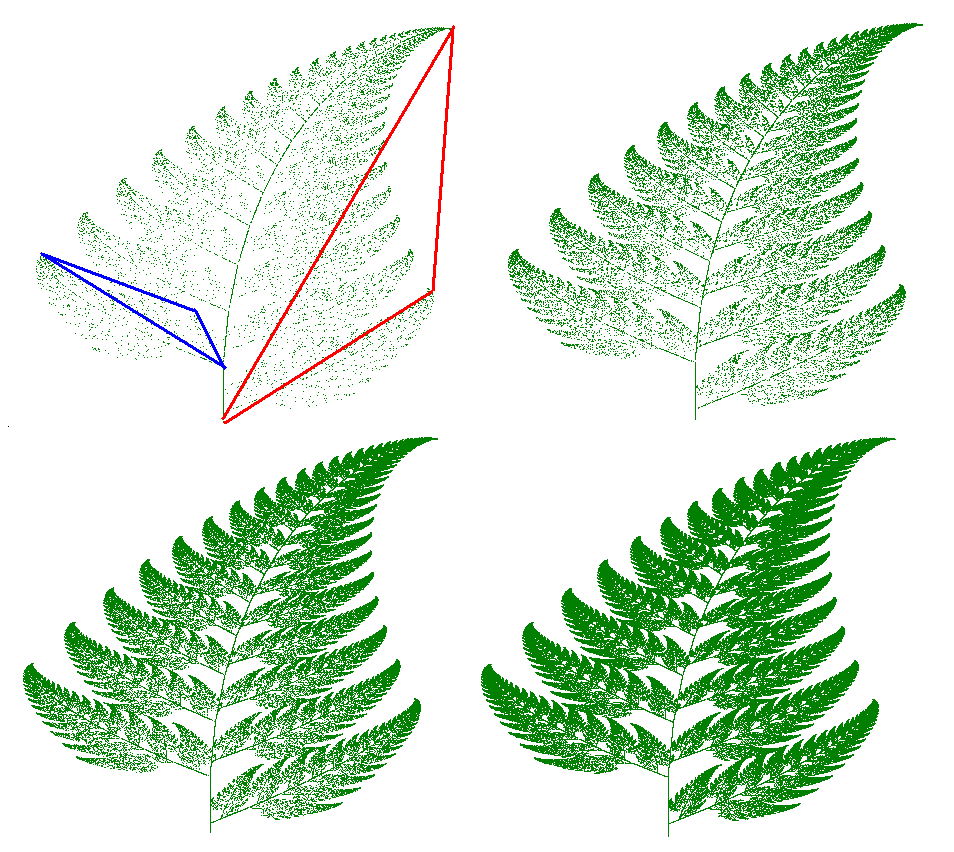Barnsley's Fern on:
[Wikipedia]
[Google]
[Amazon]
 The Barnsley fern is a
The Barnsley fern is a
Boston, MA: Academic Press, 1993, He made it to resemble the black spleenwort, ''
 The fern is one of the basic examples of
The fern is one of the basic examples of
 Though Barnsley's fern could in theory be plotted by hand with a pen and graph paper, the number of iterations necessary runs into the tens of thousands, which makes use of a computer practically mandatory. Many different computer models of Barnsley's fern are popular with contemporary mathematicians. As long as math is programmed correctly using Barnsley's matrix of constants, the same fern shape will be produced.
The first point drawn is at the origin () and then the new points are iteratively computed by randomly applying one of the following four coordinate transformations:
:
::
::
This coordinate transformation is chosen 1% of the time and just maps any point to a point in the first line segment at the base of the stem. In the iterative generation, it acts as a reset to the base of the stem. Crucially it does not reset exactly to (0,0) which allows it to fill in the base stem which is translated and serves as a kind of "kernel" from which all other sections of the fern are generated via transformations , , .
:
::
::
This transformation encodes the self-similarity relationship of the entire fern with the sub-structure which consists of the fern with the removal of the section which includes the bottom two leaves. In the matrix representation, it can be seen to be a slight clockwise rotation, scaled to be slightly smaller and translated in the positive direction. In the iterative generation, this transformation is applied with probability 85% and is intuitively responsible for the generation of the main stem, and the successive vertical generation of the leaves on either side of the stem from their "original" leaves at the base.
:
::
::
This transformation encodes the self-similarity of the entire fern with the bottom left leaf. In the matrix representation, it is seen to be a near-90° counterclockwise rotation, scaled down to approximately 30% size with a translation in the positive direction. In the iterative generation, it is applied with probability 7% and is intuitively responsible for the generation of the lower-left leaf.
:
::
::
Similarly, this transformation encodes the self-similarity of the entire fern with the bottom right leaf. From its determinant it is easily seen to include a reflection and can be seen as a similar transformation as albeit with a reflection about the -axis. In the iterative-generation, it is applied with probability 7% and is responsible for the generation of the bottom right leaf.
Though Barnsley's fern could in theory be plotted by hand with a pen and graph paper, the number of iterations necessary runs into the tens of thousands, which makes use of a computer practically mandatory. Many different computer models of Barnsley's fern are popular with contemporary mathematicians. As long as math is programmed correctly using Barnsley's matrix of constants, the same fern shape will be produced.
The first point drawn is at the origin () and then the new points are iteratively computed by randomly applying one of the following four coordinate transformations:
:
::
::
This coordinate transformation is chosen 1% of the time and just maps any point to a point in the first line segment at the base of the stem. In the iterative generation, it acts as a reset to the base of the stem. Crucially it does not reset exactly to (0,0) which allows it to fill in the base stem which is translated and serves as a kind of "kernel" from which all other sections of the fern are generated via transformations , , .
:
::
::
This transformation encodes the self-similarity relationship of the entire fern with the sub-structure which consists of the fern with the removal of the section which includes the bottom two leaves. In the matrix representation, it can be seen to be a slight clockwise rotation, scaled to be slightly smaller and translated in the positive direction. In the iterative generation, this transformation is applied with probability 85% and is intuitively responsible for the generation of the main stem, and the successive vertical generation of the leaves on either side of the stem from their "original" leaves at the base.
:
::
::
This transformation encodes the self-similarity of the entire fern with the bottom left leaf. In the matrix representation, it is seen to be a near-90° counterclockwise rotation, scaled down to approximately 30% size with a translation in the positive direction. In the iterative generation, it is applied with probability 7% and is intuitively responsible for the generation of the lower-left leaf.
:
::
::
Similarly, this transformation encodes the self-similarity of the entire fern with the bottom right leaf. From its determinant it is easily seen to include a reflection and can be seen as a similar transformation as albeit with a reflection about the -axis. In the iterative-generation, it is applied with probability 7% and is responsible for the generation of the bottom right leaf.

 By playing with the coefficients, it is possible to create mutant fern varieties. In his paper on V-variable fractals, Barnsley calls this trait a ''superfractal''.
One experimenter has come up with a table of coefficients to produce another remarkably naturally looking fern however, resembling the ''
By playing with the coefficients, it is possible to create mutant fern varieties. In his paper on V-variable fractals, Barnsley calls this trait a ''superfractal''.
One experimenter has come up with a table of coefficients to produce another remarkably naturally looking fern however, resembling the ''A Barnsley fern generator
/ref> :
 The Barnsley fern is a
The Barnsley fern is a fractal
In mathematics, a fractal is a Shape, geometric shape containing detailed structure at arbitrarily small scales, usually having a fractal dimension strictly exceeding the topological dimension. Many fractals appear similar at various scale ...
named after the British mathematician
A mathematician is someone who uses an extensive knowledge of mathematics in their work, typically to solve mathematical problems. Mathematicians are concerned with numbers, data, quantity, mathematical structure, structure, space, Mathematica ...
Michael Barnsley
Michael Fielding Barnsley (born 1946) is a British mathematician, researcher and an entrepreneur who has worked on fractal compression; he holds several patents on the technology. He received his Ph.D. in theoretical chemistry from University of W ...
who first described it in his book ''Fractals Everywhere''.Fractals EverywhereBoston, MA: Academic Press, 1993, He made it to resemble the black spleenwort, ''
Asplenium adiantum-nigrum
''Asplenium adiantum-nigrum'' is a common species of fern known by the common name black spleenwort. It is found mostly in Africa, Europe, and Eurasia, but is also native to a few locales in Mexico and the United States.
Description
This spleen ...
''.
History
 The fern is one of the basic examples of
The fern is one of the basic examples of self-similar
In mathematics, a self-similar object is exactly or approximately similar to a part of itself (i.e., the whole has the same shape as one or more of the parts). Many objects in the real world, such as coastlines, are statistically self-similar ...
sets, i.e. it is a mathematically generated pattern that can be reproducible at any magnification or reduction. Like the Sierpinski triangle, the Barnsley fern shows how graphically beautiful structures can be built from repetitive uses of mathematical formulas with computers. Barnsley's 1988 book ''Fractals Everywhere'' is based on the course which he taught for undergraduate and graduate students in the School of Mathematics, Georgia Institute of Technology
The Georgia Institute of Technology (commonly referred to as Georgia Tech, GT, and simply Tech or the Institute) is a public university, public research university and Institute of technology (United States), institute of technology in Atlanta, ...
, called ''Fractal Geometry''. After publishing the book, a second course was developed, called ''Fractal Measure Theory''. Barnsley's work has been a source of inspiration to graphic artists
A graphic designer is a practitioner who follows the discipline of graphic design, either within companies or organizations or independently. They are professionals in design and visual communication, with their primary focus on transforming l ...
attempting to imitate nature with mathematical models.
The fern code developed by Barnsley is an example of an iterated function system
In mathematics, iterated function systems (IFSs) are a method of constructing fractals; the resulting fractals are often self-similar. IFS fractals are more related to set theory than fractal geometry. They were introduced in 1981.
IFS fractals ...
(IFS) to create a fractal. This follows from the collage theorem. He has used fractals to model a diverse range of phenomena
in science and technology, but most specifically plant structures.
—Michael Barnsley ''et al.''Michael Barnsley
Michael Fielding Barnsley (born 1946) is a British mathematician, researcher and an entrepreneur who has worked on fractal compression; he holds several patents on the technology. He received his Ph.D. in theoretical chemistry from University of W ...
, ''et al.'',
Construction
Barnsley's fern uses fouraffine transformation
In Euclidean geometry, an affine transformation or affinity (from the Latin, '' affinis'', "connected with") is a geometric transformation that preserves lines and parallelism, but not necessarily Euclidean distances and angles.
More general ...
s. The formula for one transformation is the following:
:
Barnsley shows the ''IFS'' code for his ''Black Spleenwort'' fern fractal as a matrix of values shown in a table.''Fractals Everywhere'', table III.3, IFS code for a fern. In the table, the columns "" through "" are the coefficients of the equation, and "" represents the probability factor.
:
These correspond to the following transformations:
:
Computer generation
Mutant varieties
Cyclosorus
''Cyclosorus'' is a genus of ferns in the family Thelypteridaceae, subfamily Thelypteridoideae, in the Pteridophyte Phylogeny Group classification of 2016 (PPG I). Other sources sink ''Cyclosorus'' into a very broadly defined genus ''Thelypteri ...
'' or ''Thelypteridaceae
Thelypteridaceae is a family of about 900 species of ferns in the order Polypodiales. In the Pteridophyte Phylogeny Group classification of 2016 (PPG I), it is placed in the suborder Aspleniineae. Alternatively, the family may be submerged in a ...
'' fern. These are:/ref> :
Pseudocode
References
{{Digital art Affine geometry L-systems Articles with example R code Articles with example Python (programming language) code